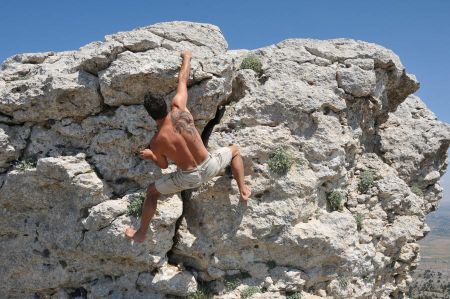Free climbing with courage - two climbers show their skills
- Written by Portal Editor
What do paragliders, at least some of them, do when wind and weather conditions do not offer good flight conditions? Yes, right, you climb freely and without any equipment on the rocks of the take off.
We were amazed when the two exceptional pilots Robert Blum and Pal Takats suddenly and without any prior notice set out on the way to a huge boulder lying on the summit, bared their upper bodies and quickly pulled a path along the rock. Robert in particular showed his alpine origins here, as skilfully as a mountain goat he mastered overhangs, crevices and loose rock, all without footwear. However, Pal showed more than just physical dexterity and was almost always able to follow Robert. Both pilots clearly enjoyed it, so that the Australian-based pilot Sebastian Benz also joined them. Here it became clear how well-trained a paraglider should be in order to be able to control the device safely and over a long period of time.
Free climbing - exercise elements to increase fitness
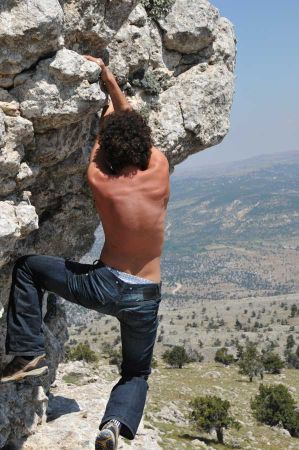 In this way we learned more details about free climbing, a physical activity in which only hands and feet are allowed to move. Of course, even the best climber should always think about their safety and use aids to secure them. As soon as it is used to move, the climbing friends give a clear no. The word “free” does not mean free of technical aids for personal safety, but merely the renunciation of aids for movement. A route to be mastered is therefore only considered conquered when it can be conquered freely without technical aids such as hooks and eyes.
In this way we learned more details about free climbing, a physical activity in which only hands and feet are allowed to move. Of course, even the best climber should always think about their safety and use aids to secure them. As soon as it is used to move, the climbing friends give a clear no. The word “free” does not mean free of technical aids for personal safety, but merely the renunciation of aids for movement. A route to be mastered is therefore only considered conquered when it can be conquered freely without technical aids such as hooks and eyes.
Since our free climbers didn't have these aids anyway, only hands and feet were really used. However, both pilots always secured each other by being close to the respective climbing and never climbing higher than stomach height on the rock. However, we used different perspectives to create the photos, which suggested different climbing heights.
Historical background to free climbing (wikipedia)
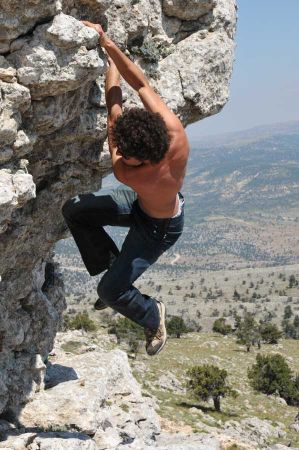 This climbing style has been developing in Saxon Switzerland since around 1890, when attempts were made to completely dispense with artificial aids for climbing the summit. At the beginning of the local climbing tradition since 1864, artificial aids such as ladders and metal pins were initially used.
This climbing style has been developing in Saxon Switzerland since around 1890, when attempts were made to completely dispense with artificial aids for climbing the summit. At the beginning of the local climbing tradition since 1864, artificial aids such as ladders and metal pins were initially used.
The first climbing guide with corresponding rules was published in 1908 by Rudolf Fehrmann ("The Mountaineer in Saxon Switzerland"). In 1913 the Saxon climbing rules were published in an addendum. These have been in effect since then and have been maintained and followed in Saxon Switzerland over the decades. These rules were partly adopted in other areas (Palatinate, Battert, Zittau Mountains) or served as a model there. In 1923 a supplementary edition appeared for the first time with a division into seven levels of difficulty.
The Saxon mountaineer Fritz Wiessner emigrated to the USA in the 1930s. There they were popularized by him and used by many climbers (especially climbers in Camp 4 of Yosemite National Park, the then climbing center of the USA), who pushed climbing to new levels of difficulty in the 1970s. As a result, Wiessner significantly influenced the mountaineering ethics prevailing there.
Free climbing back to Europe
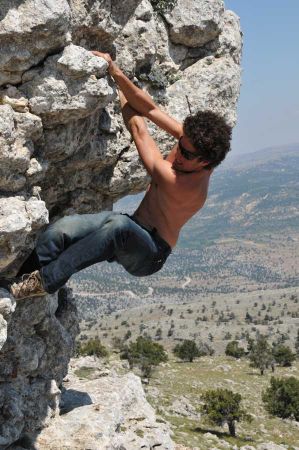 Around 1970 free climbing came back to West Germany and later all of Europe via West German climbers who climbed in the Yosemite National Park and also in Saxon Switzerland. Thanks to visits to Saxon Switzerland with climbers like Bernd Arnold, which were difficult to organize before 1990, Kurt Albert and other climbers had seen that it was possible to conquer difficult pieces of rock without using artificial aids to move. In the Federal Republic of Germany, Kurt Albert in particular introduced free climbing from 1975 with the term red point climbing. In the years that followed, the Austrian climber and mountain photographer Heinz Zak was not entirely uninvolved in this renaissance in Europe: he often climbed such routes himself and documented them in high photographic quality, so that they became known through the specialist magazines and a larger audience found. Until then (1970s) climbing routes in West Germany were often mastered with the help of hooks, rope ladders and similar aids, what is now called technical climbing. In Saxon Switzerland it was and is still practiced according to the old rules, whereby the red dot concept has also prevailed there. Technical climbing was never accepted in Saxon Switzerland.
Around 1970 free climbing came back to West Germany and later all of Europe via West German climbers who climbed in the Yosemite National Park and also in Saxon Switzerland. Thanks to visits to Saxon Switzerland with climbers like Bernd Arnold, which were difficult to organize before 1990, Kurt Albert and other climbers had seen that it was possible to conquer difficult pieces of rock without using artificial aids to move. In the Federal Republic of Germany, Kurt Albert in particular introduced free climbing from 1975 with the term red point climbing. In the years that followed, the Austrian climber and mountain photographer Heinz Zak was not entirely uninvolved in this renaissance in Europe: he often climbed such routes himself and documented them in high photographic quality, so that they became known through the specialist magazines and a larger audience found. Until then (1970s) climbing routes in West Germany were often mastered with the help of hooks, rope ladders and similar aids, what is now called technical climbing. In Saxon Switzerland it was and is still practiced according to the old rules, whereby the red dot concept has also prevailed there. Technical climbing was never accepted in Saxon Switzerland.
Difficulty levels according to the UIAA scale
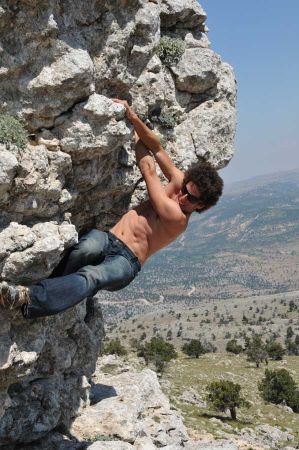 Depending on how demanding a climbing route is, it is divided into different levels of difficulty. The degree of the route is often based on the most difficult part of the way. In the optimal case, degrees of difficulty are not influenced by the personal preferences of the evaluating person, but should represent an assessment of the climbing difficulty that is as objective as possible. However, since this is often difficult to achieve, heated discussions occur again and again, especially with high levels of difficulty.
Depending on how demanding a climbing route is, it is divided into different levels of difficulty. The degree of the route is often based on the most difficult part of the way. In the optimal case, degrees of difficulty are not influenced by the personal preferences of the evaluating person, but should represent an assessment of the climbing difficulty that is as objective as possible. However, since this is often difficult to achieve, heated discussions occur again and again, especially with high levels of difficulty.
Different levels of difficulty are used in different countries and climbing areas. In Germany, the UIAA scale has largely prevailed, in Saxony the Saxon scale is still used. There are also the American scales: Yosemite Decimal System (YDS) and National Climbing Classification System (NCCS), as well as Australian, Norwegian and Swedish scales. In Europe, the French rating has now established itself, while the English rating also takes account of the psychological stress of a route.
Please also read:
Lake Garda Ferratas - Via ferratas near Riva del Garda
Short city trip to Passau - the town shows signs of autumn
-
 Free-Climbing with Robert and Pal in Mut
Free-Climbing with Robert and Pal in Mut
Free-Climbing with Robert and Pal in Mut
Free-Climbing with Robert and Pal in Mut
-
 Free-Climbing with Robert and Pal in Mut
Free-Climbing with Robert and Pal in Mut
Free-Climbing with Robert and Pal in Mut
Free-Climbing with Robert and Pal in Mut
-
 Free-Climbing with Robert and Pal in Mut
Free-Climbing with Robert and Pal in Mut
Free-Climbing with Robert and Pal in Mut
Free-Climbing with Robert and Pal in Mut
-
 Free-Climbing with Robert and Pal in Mut
Free-Climbing with Robert and Pal in Mut
Free-Climbing with Robert and Pal in Mut
Free-Climbing with Robert and Pal in Mut
-
 Free-Climbing with Robert and Pal in Mut
Free-Climbing with Robert and Pal in Mut
Free-Climbing with Robert and Pal in Mut
Free-Climbing with Robert and Pal in Mut
-
 Free-Climbing with Robert and Pal in Mut
Free-Climbing with Robert and Pal in Mut
Free-Climbing with Robert and Pal in Mut
Free-Climbing with Robert and Pal in Mut
-
 Free-Climbing with Robert and Pal in Mut
Free-Climbing with Robert and Pal in Mut
Free-Climbing with Robert and Pal in Mut
Free-Climbing with Robert and Pal in Mut
-
 Free-Climbing with Robert and Pal in Mut
Free-Climbing with Robert and Pal in Mut
Free-Climbing with Robert and Pal in Mut
Free-Climbing with Robert and Pal in Mut
-
 Free-Climbing with Robert and Pal in Mut
Free-Climbing with Robert and Pal in Mut
Free-Climbing with Robert and Pal in Mut
Free-Climbing with Robert and Pal in Mut
-
 Free-Climbing with Robert and Pal in Mut
Free-Climbing with Robert and Pal in Mut
Free-Climbing with Robert and Pal in Mut
Free-Climbing with Robert and Pal in Mut
-
 Free-Climbing with Robert and Pal in Mut
Free-Climbing with Robert and Pal in Mut
Free-Climbing with Robert and Pal in Mut
Free-Climbing with Robert and Pal in Mut
-
 Free-Climbing with Robert and Pal in Mut
Free-Climbing with Robert and Pal in Mut
Free-Climbing with Robert and Pal in Mut
Free-Climbing with Robert and Pal in Mut
-
 Free-Climbing with Robert and Pal in Mut
Free-Climbing with Robert and Pal in Mut
Free-Climbing with Robert and Pal in Mut
Free-Climbing with Robert and Pal in Mut
-
 Free-Climbing with Robert and Pal in Mut
Free-Climbing with Robert and Pal in Mut
Free-Climbing with Robert and Pal in Mut
Free-Climbing with Robert and Pal in Mut
-
 Free-Climbing with Robert and Pal in Mut
Free-Climbing with Robert and Pal in Mut
Free-Climbing with Robert and Pal in Mut
Free-Climbing with Robert and Pal in Mut
https://www.alaturka.info/en/turkey-country/riviera/5305-free-climbing-with-courage-two-climbers-show-their-skills#sigProId53fa9d9699
